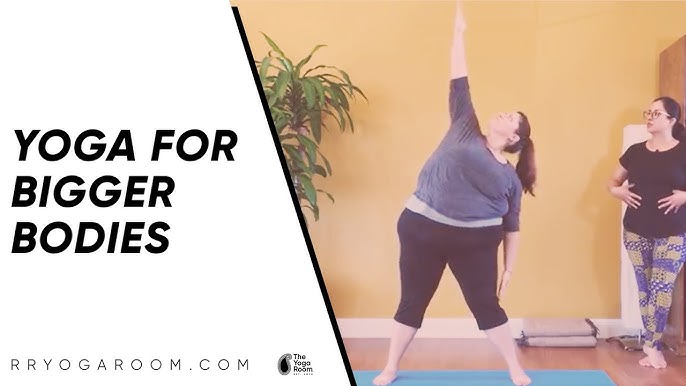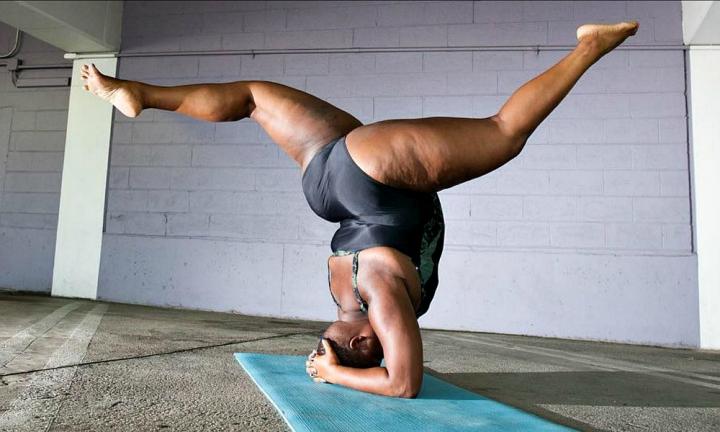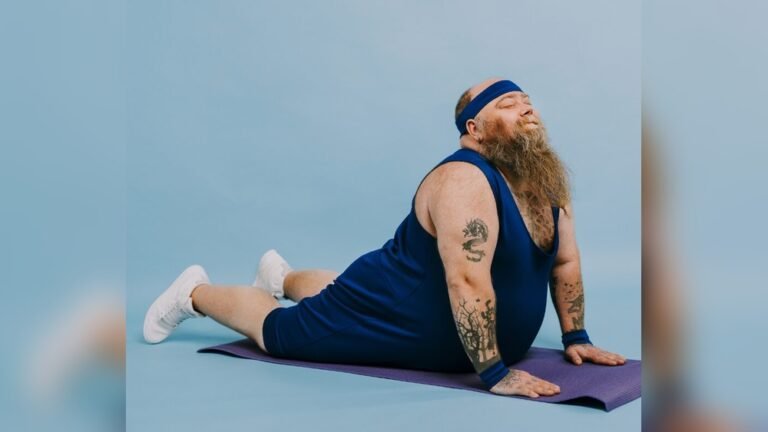If you’ve ever wondered whether yoga is something you can do comfortably and safely as an obese individual, the answer is a resounding yes. Yoga isn’t just for flexible, slim bodies—it’s for every body, including yours.
Imagine a practice that supports your strength, boosts your flexibility, and calms your mind, all while moving at a pace that feels right for you. Whether you’re new to exercise or looking for a gentle way to stay active, obese yoga offers modifications and tools designed to meet your unique needs.
Ready to discover how yoga can transform your body and mind without pressure or judgment? Keep reading to learn how to start, what benefits you can expect, and tips to make your practice both enjoyable and effective. Your journey to feeling stronger and more confident begins here.
Yoga For Larger Bodies
Yoga for larger bodies offers a gentle and supportive way to improve health. It welcomes people of all sizes to explore movement and mindfulness. This practice focuses on comfort and adaptability, making yoga accessible for everyone.
Many yoga styles include modifications and props to fit bigger bodies. The goal is to create a safe space for growth, strength, and relaxation. Yoga for larger bodies encourages self-awareness and respect for your limits.
Low-impact Movement
Yoga provides low-impact exercises that protect the joints and muscles. Movements are slow and controlled, reducing the risk of injury. This approach suits people who may find high-impact activities difficult. It helps build strength and flexibility without strain.
Body Awareness And Mindfulness
Yoga encourages a deep connection with the body through mindful breathing and movement. This awareness helps you understand your limits and strengths. Mindfulness reduces stress and improves emotional health. It fosters a positive relationship with your body.
Inclusivity In Yoga
Inclusive yoga embraces all body shapes and sizes without judgment. Classes often use props and offer pose variations to support every student. Instructors trained in inclusivity create welcoming environments. This support helps people feel confident and valued.

Credit: www.youtube.com
Starting Your Practice
Starting your practice in obese yoga is a journey of kindness and patience. It is important to begin with simple steps that respect your current strength and mobility. Building a solid foundation helps create lasting benefits and reduces the risk of injury.
Each person’s path is unique. Take time to find what works best for your body and mind. The following tips will guide you in setting up a safe and enjoyable practice.
Choosing The Right Class
Start with classes designed for beginners or gentle yoga. Chair yoga or classes focused on larger bodies provide a supportive environment. These classes move at a slower pace and focus on basic poses. This approach helps build confidence and strength safely.
Using Props For Support
Props like blocks, straps, and chairs offer extra support. They help make poses accessible and comfortable. Using props can improve balance and alignment. They allow you to stay longer in poses without strain. Props are tools to help your body feel steady and safe.
Adapting Poses Safely
Modify poses to fit your body’s needs. Avoid forcing yourself into uncomfortable positions. Adjusting poses prevents injury and builds strength gradually. Remember, yoga is about how you feel, not how you look. Adaptations make the practice accessible and enjoyable.
Listening To Your Body
Pay close attention to your body’s signals. Move slowly and breathe deeply through each pose. Stop or rest when you feel pain or discomfort. Respect your limits and celebrate small progress. Your body knows best what it can handle today.
Finding The Right Instructor
Choose instructors experienced with larger bodies and inclusive practices. A good teacher offers encouragement and clear guidance. They understand how to modify poses safely for all sizes. Feeling supported by your instructor builds trust and motivation. This connection makes your yoga journey positive and uplifting.
Easy Poses For Beginners
Starting yoga as a beginner can feel challenging, especially for those with larger bodies. Easy poses help build confidence and strength gently. These poses focus on comfort and safety while promoting flexibility and balance. Beginners can enjoy yoga’s benefits by practicing simple movements and breathing techniques. Here are some easy yoga poses designed for beginners to try.
Chair Yoga Basics
Chair yoga uses a sturdy chair for support and balance. It allows beginners to practice yoga without standing or lying on the floor. Simple movements include seated twists, gentle stretches, and arm raises. Chair yoga helps improve posture and flexibility safely. It is ideal for those with limited mobility or balance concerns.
Gentle Standing Poses
Standing poses build strength and stability while improving balance. Start with poses like mountain pose, tree pose, and warrior II. Use a wall or chair for extra support if needed. These poses strengthen legs and core muscles while enhancing focus. Move slowly and breathe deeply to maintain comfort.
Seated Stretching Exercises
Seated stretches increase flexibility and reduce tension in muscles. Try forward bends, side stretches, and gentle spinal twists while sitting on the floor or a chair. These exercises ease tightness in the back, hips, and legs. Seated stretches can be done daily for better mobility and relaxation.
Breath And Relaxation Techniques
Breath control calms the mind and supports physical practice. Simple breathing exercises include deep belly breaths and slow exhales. Practice these techniques before and after yoga poses. Relaxation methods like guided meditation help reduce stress and improve mental clarity. Breath and relaxation are key to a balanced yoga practice.
Benefits For Body And Mind
Obese yoga offers many benefits for both body and mind. It helps people move gently while respecting their unique needs. The practice encourages strength, flexibility, and calmness. Yoga can improve physical health and boost mental wellness.
With simple adjustments and supportive tools, obese yoga suits all levels. It promotes confidence and a sense of well-being. Regular practice can lead to lasting changes in how the body and mind feel.
Building Strength And Flexibility
Obese yoga helps build muscle strength safely. Poses focus on gentle movements that tone key areas. Flexibility improves as muscles stretch without strain. Increased strength supports daily activities and reduces injury risk. Over time, joints become more mobile and less stiff.
Stress Relief And Mental Wellness
Yoga calms the mind through breath and focus. It reduces stress by encouraging relaxation and presence. Regular practice can lower anxiety and improve mood. Mindfulness in yoga helps develop patience and self-acceptance. This mental balance supports overall emotional health.
Weight Management Support
Yoga encourages mindful eating and body awareness. It gently boosts metabolism and energy levels. Moving the body increases calorie burning without harsh strain. Yoga helps reduce emotional eating caused by stress. Combined with healthy habits, it supports weight management goals.
Improved Mobility And Balance
Obese yoga enhances coordination and body control. Improved balance lowers the chance of falls and injuries. Gentle stretches increase joint range of motion. Better mobility leads to easier movement in daily life. This freedom fosters independence and confidence.
Overcoming Challenges
Starting yoga as an obese person can bring unique challenges. These challenges may affect your progress and experience. Understanding how to overcome them helps you enjoy yoga fully. Patience and kindness toward yourself are key.
Each challenge can be managed with the right approach. Small steps lead to big changes. Here are some important tips to help you stay on track.
Managing Expectations
Yoga is a journey, not a quick fix. Progress may be slow but steady. Focus on how you feel, not just on how poses look. Avoid comparing yourself to others in class. Celebrate small wins and improvements in flexibility or strength.
Be realistic about what your body can do today. Some poses may be hard or impossible at first. That is normal. Keep practicing and adapting. Improvement comes with time and patience.
Avoiding Injury
Injuries can stop your progress and cause pain. Always listen to your body’s signals. Avoid pushing too hard or forcing poses. Use props like blocks and straps to support your body. Modify poses to suit your abilities and comfort.
Choose classes designed for larger bodies or beginners. A good teacher can guide you safely. Warm up well before starting and cool down after. Consistent gentle practice helps build strength without harm.
Staying Motivated
Motivation can dip during tough times. Set small, clear goals to keep focused. Track your progress in a journal or app. Find joy in the practice, not just the results. Try different styles or teachers to keep it fresh.
Join supportive groups or classes with others who share your goals. Celebrate every step forward. Remember why you started and how yoga helps your body and mind.
Handling Social Perceptions
Social judgment can feel discouraging. Yoga is for all body types and sizes. Your presence in class matters. Focus on your own practice, not others’ opinions. Confidence grows with regular practice and self-acceptance.
Seek inclusive classes or communities that celebrate diversity. Surround yourself with positive support. Remember, your health and happiness come first.

Credit: www.thisismoney.co.uk
Specialized Yoga Styles
Specialized yoga styles offer tailored approaches for individuals with larger bodies. These styles focus on comfort, accessibility, and safety. They adapt traditional yoga poses to fit different body shapes and sizes. This ensures everyone can experience the benefits of yoga without strain or injury.
Heavyweight Yoga
HeavyWeight Yoga is designed specifically for bigger bodies. It uses props and modified poses to support joints and muscles. The practice encourages body positivity and self-acceptance. Classes often include gentle stretching and strength-building exercises. This style helps improve flexibility and balance safely.
Chair Yoga
Chair Yoga allows participants to practice yoga while seated or using a chair for support. It is ideal for those with limited mobility or balance issues. This style reduces the risk of falls and joint stress. Movements are slow and controlled, focusing on breathing and gentle stretches. Chair Yoga makes yoga accessible to many people.
Gentle And Restorative Yoga
Gentle and Restorative Yoga focuses on slow, calming movements. It uses props like bolsters, blankets, and blocks to support the body fully. This style helps release tension and promotes deep relaxation. It is excellent for beginners or those recovering from injury. The practice encourages mindfulness and stress relief.
Online Resources And Communities
Online platforms offer many classes for obese yoga practitioners. These resources provide video tutorials, tips, and modifications. They create a supportive space to share experiences and progress. Joining communities helps maintain motivation and connect with others. Many instructors specialize in adaptive yoga for larger bodies.
Health Considerations
Practicing yoga as an obese individual involves special health considerations. These help ensure safety and maximize benefits. Paying attention to health needs prevents injury and supports steady progress. The practice should suit your body’s current state and health conditions. Understanding these points makes yoga a positive experience.
Consulting Healthcare Providers
Talk with your doctor before starting yoga. Share your health history and any concerns. Your doctor can suggest safe activity levels. They may recommend specific types of yoga or poses to avoid. This step helps prevent health risks and guides your practice.
Setting Realistic Goals
Set small, clear goals for your yoga journey. Focus on improving flexibility, strength, or relaxation. Avoid aiming for advanced poses too soon. Goals should match your current ability and health. Celebrate small wins to stay motivated and confident.
Tracking Progress Safely
Keep a simple record of your yoga sessions and feelings. Note any pain or discomfort and share with your healthcare provider. Use gentle feedback from your body to adjust practice intensity. Progress is about feeling better, not pushing too hard. Safety is key to lasting benefits.

Credit: www.kidspot.com.au
Frequently Asked Questions
Can You Do Yoga If You Are Obese?
Yes, obese individuals can practice yoga safely. Choose gentle or chair yoga, use props, and modify poses to fit your body. Yoga improves strength, flexibility, and mental health. Always consult a doctor before starting and listen to your body for a safe, effective practice.
Which Yoga Is Best For Obese People?
Gentle yoga, chair yoga, and HeavyWeight Yoga suit obese individuals best. These low-impact styles build strength, flexibility, and support safe movement. Using props and modifications helps adapt poses comfortably. Consistent practice improves physical and mental health while aiding weight management.
Always consult a doctor before starting.
Is Yoga Good For Obesity?
Yoga supports obesity management by improving flexibility, strength, and mental health. It offers low-impact exercise, aids weight loss, and suits all body types with modifications.
What Is The Best Exercise If You Are Obese?
The best exercise for obese individuals is gentle yoga or chair yoga. These low-impact exercises improve strength, flexibility, and mental well-being safely. Use props and modifications to suit your body. Always start slowly and consult a doctor before beginning any new workout routine.
Conclusion
Obese yoga offers a gentle way to improve health and well-being. It helps build strength, flexibility, and calm the mind. Everyone can find a pace and style that suits their needs. Using props and modifications makes poses easier and safer.
Regular practice supports both body and mental health over time. Patience and kindness toward yourself are essential for progress. Yoga welcomes all body types with open arms and respect. Start small, stay consistent, and enjoy the journey toward better health.



